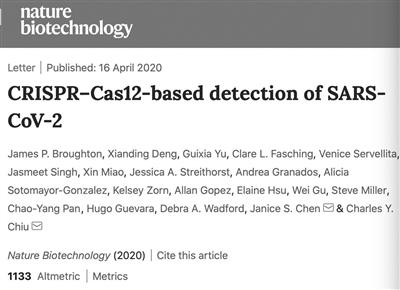CRISPR-based rapid diagnosis technology of new coronavirus appears in
45 minutes, with accuracy comparable to traditional RT-PCR detection
CRISPR-based rapid diagnosis technology of new coronavirus. Source: "Nature · Biotechnology" Online Edition
Science and Technology Daily (Reporter Zhang Mengran) In a biomedical study published on the 16th by the British magazine "Nature and Biotechnology", American scientists reported that a CRISPR-based diagnostic tool can quickly detect new coronaviruses. This diagnostic tool takes about 45 minutes to give results, with accuracy comparable to traditional RT-PCR detection.
The previous disease pandemic told people that fast and easily accessible detection methods are important for achieving an effective public health response. However, current detection methods for new coronaviruses often take hours or even days to produce results.
This time, Qiu Huayan, a researcher at the University of California, and colleagues reported a CRISPR-Cas12-based test method that can identify a new coronavirus from RNA extracted from respiratory swabs of patients with new coronavirus pneumonia. The test is called "New Coronavirus DNA Enzyme Targeting CRISPR Trans Reporting System" The test requires obtaining sample RNA, then reverse transcription it into DNA, and then amplifying it using a technique called isothermal amplification. Afterwards, the gene sequence of the new coronavirus envelope and nucleocapsid can be detected by CRISPR–Cas12, which will cleave the reporter molecule that confirms the presence of the virus.
The research team tested the system with clinical samples from 36 patients with new coronavirus pneumonia and 42 patients with other respiratory diseases. Compared with the RT-PCR test used by the US Centers for Disease Control and Prevention, the positive prediction coincidence rate of this test is 95%, and the negative prediction coincidence rate is 100%.
The previous RT-PCR test usually takes several hours, and requires special equipment to perform hot and cold cycles; compared with the latest CRISPR-based method, which only has two fixed operating temperatures, it can be done after about 45 minutes Like the home pregnancy test, read the results on the visual readout.

